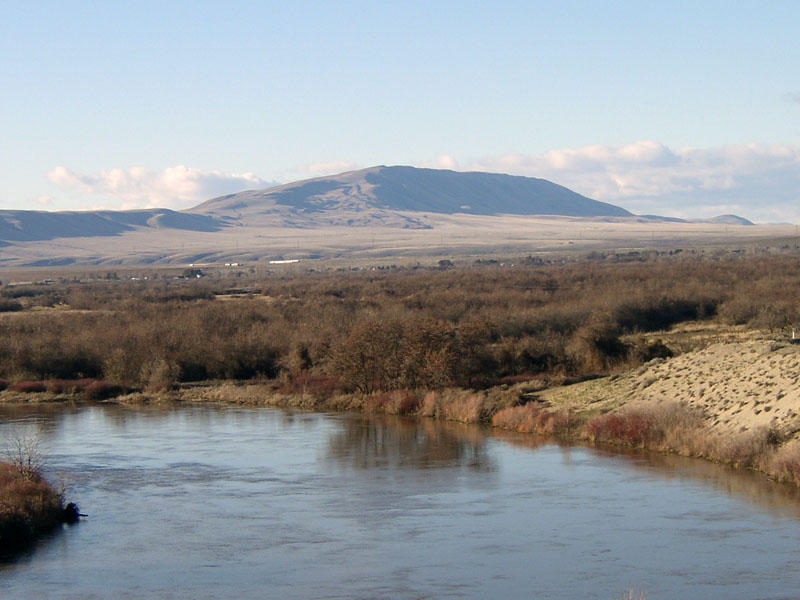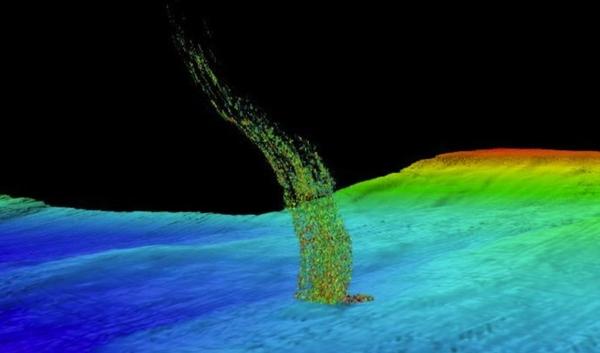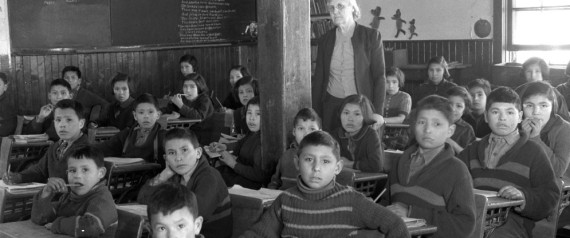Tribes Object To Forced Opening Of ‘Sacred Mountain’ To Public

Umptanum Wikimedia
By Tom Banse, Northwest News Network
The Yakama Nation and neighboring tribes are strongly objecting to a Congressional move to offer public access to the summit of Rattlesnake Mountain, a place tribal members consider sacred.
The mountain lies in the Hanford Reach National Monument near Richland, Washington.
Central Washington’s outgoing Republican Congressman Doc Hastings authored the requirement that the federal government provide some degree of public access. The provision is now tacked on to a must-pass defense spending bill.
Access to the windswept, treeless mountain overlooking the Hanford nuclear site is currently highly restricted. Philip Rigdon supervises the Yakama Nation Department of Natural Resources. He said the summit of Rattlesnake Mountain should remain off-limits to the general public.
“The mountain is a place that is critical to our culture, our religion and the ceremonies that we continue to perform today,” Rigdon said.
But Rigdon’s arguments may be in vain. A Democratic Senate staffer said the defense spending bill now includes so many unrelated member requests, it’s expected to pass by a wide margin this week.
Last week, the 2015 National Defense Authorization Act won U.S. House approval on a bipartisan 300-119 vote. Many public lands provisions that have been bottled up in the divided Congress for years have now been folded into the mammoth bill.
Some of the measures of Northwest interest would expand the Oregon Caves National Monument and Alpine Lakes Wilderness and protect the Hanford B Reactor as part of a new Manhattan Project National Historical Park.
Representative Hastings had long sought to force the U.S. Fish and Wildlife Service, the relevant land manager, through legislation to provide greater access to Rattlesnake Mountain. The House unanimously passed such a bill in 2013, but it died without a hearing in the Democrat-controlled Senate.
“The views of Indian tribes are legitimate, and they have a right to be heard and consulted,” Hastings said during an earlier House committee hearing. “But the views of local communities and all citizens also deserve to be heard and listened to — and there is overwhelming local public support for access to the summit of Rattlesnake Mountain.”
“The public should expect that if they can visit the summit of Mt. Rainier, then they certainly should be allowed to the summit of Rattlesnake Mountain,” Hastings said as he described the “unparalled views” of the Columbia Basin from the ridge. A gated, paved road leads to the summit.
The Native American name for Rattlesnake Mountain is “Laliik.” Rigdon said Columbia Plateau tribes such as the Yakama, Umatilla and Nez Perce want to preserve the “spiritual” qualities of a holy place.
“It’s astonishing to me that we continue this total disregard for our religion, our ceremonies and this place that has provided for us,” concluded Rigdon.
“Laliik is our Mount Sinai,” Yakama tribal Chairman JoDe Goudy wrote in a recent letter to U.S. senators. “When our Long House leaders feel that a young adult is ready and worthy, Laliik is where they are sent to fast and to have vision quests. This is not a place for Airstreams and Winnebagos.”
The Rattlesnake Mountain provision is one of several aspects of the defense spending bill that trouble tribes. The Yakama Nation chairman also wrote to oppose the transfer of more than 1,000 acres of surplus land at the urbanized edge of the Department of Energy’s Hanford Site for economic development.
Northwest tribes are also joining in solidarity with Native bands in the Southwest who object to the transfer of Tonto National Forest land to a private company that plans to mine for copper.
Coho Salmon Eggs Put to the Stormwater Test

By Northwest Indian Fisheries Commission
Peering through a microscope at the Suquamish Tribe’s Grovers Creek Hatchery, biologist Tiffany Linbo uses two pairs of tweezers to gently peel the protective layer off an 18-day-old fertilized coho salmon egg.
The National Oceanic and Atmospheric Administration (NOAA) biologist needs to do it without piercing the yolk sac so Washington State University (WSU) toxicologist Jen McIntyre can take a closer look at the embryo’s health and development, such as heartbeat, blood flow and eye size.
Linbo and McIntyre are looking at eggs that have been exposed to urban stormwater runoff collected from roadways in Seattle; they want to know if the embryos show signs of developmental toxicity.
In a partnership with the tribe, the project is part of an ongoing study by NOAA, WSU, U.S. Fish and Wildlife Service, and Environmental Protection Agency to better understand how untreated urban stormwater is affecting coho salmon during their freshwater life stages in urban Puget Sound watersheds.
While it may be obvious that polluted water may be hazardous to salmon, “some as-yet unidentified chemicals in runoff are prematurely killing adult salmon as they attempt to spawn in urban streams,” said David Baldwin, NOAA research zoologist who helped design the study.
Since 2011, the scientists have been conducting similar exposure tests on adult coho salmon, studying fish behavior and toxicity levels in the organs. They have profiled the baseline chemistry of urban runoff across multiple storms, spanning multiple years.
The scientists are looking at the effects of different dilutions of stormwater on embryos compared to embryos exposed only to the hatchery’s clean well water. The team also is monitoring the development of eggs exposed to full-strength stormwater first filtered through experimental soil columns filled with sand, compost and mulch, mimicking bioswale filtration systems.
As for the eggs, it will take more than one storm to tell the story.
“We expect it will take multiple short exposures before we see effects on the eggs,” McIntyre said. “If the contaminants target the gills, the liver or the heart of the adults, those organs were not yet developed when we did the first exposure to the eggs.”
“In actual urban spawning habitats, salmon embryos develop over a period several weeks, during which they are likely to experience repeated rain events,” added Julann Spromberg, NOAA toxicologist. “We want our study to reflect this reality of multiple exposures.”
Warming Ocean May Be Triggering Mega Methane Leaks Off Northwest Coast

By Ashley Ahearn, KUOW
SEATTLE — As the waters of the Pacific warm, methane that was trapped in crystalline form beneath the seabed is being released. And fast.
New modeling suggests that 4 million tons of this potent greenhouse gas have escaped since 1970 from the ocean depths off Washington’s coast.
“We calculate that methane equivalent in volume to the Deepwater Horizon oil spill is released every year off the Washington coast,” said Evan Solomon, a University of Washington assistant professor of oceanography and co-author of the new paper, which was published in the journal Geophysical Research Letters. The modeling does not indicate whether the rate of release has changed as temperatures warm, but it does strengthen the connection between ocean temperature and methane behavior.
Solomon and his colleagues first learned about the methane leaks when fishermen started sending them photographs of bubbles coming up out of the deep.
“They’re really low quality phone shots of their fish finders, but every single location they gave us was 100 percent accurate,” Solomon said.
On a cruise this past summer, Solomon and his colleagues gathered core samples from the ocean floor, about one-third of a mile deep, at the spots where the fishermen reported seeing bubbles.
And sure enough, mixed in among the sediment, were crystalized methane deposits.
“It looks like slushy ice,” Solomon said. But it certainly behaves differently. “If you took it from the sediment and lit a match or put a lighter on it, it will go into flames because of all the gas.”
Methane can exist in a gas, liquid and crystalline form. The crystalline version, or methane hydrate, occurs at cold temperatures and under pressure – conditions that can be found at certain depths of the ocean. But as deep sea waters warm, scientists believe those crystals will dissolve, releasing the methane in bubbles that can change ocean chemistry and contribute to atmospheric change once they escape at the sea’s surface.
“It’s a way to contribute to ocean acidification if you have a lot of this gas coming out and being oxidized in the water column,” Solomon said.
The methane release isn’t just happening in Washington waters, Solomon says. More sampling needs to be done but the same conditions for methane hydrate release exist from Northern California to Alaska. “So it’s not a Washington central thing,” says Solomon, who is looking forward to further study of this issue. “It should be happening off of Oregon, off of British Columbia as well.”
Other research has found similar patterns of methane release in the Atlantic and off the coast of Alaska.
“It’s a hot topic,” Solomon said.
Rep. Paul Gosar Calls Native Americans ‘Wards Of The Federal Government’

By Felicia Fonseca, AP
FLAGSTAFF, Ariz. (AP) — U.S. Rep. Paul Gosar’s reference to American Indians as “wards of the federal government” has struck a harsh chord with tribal members and legal experts in the days following a discussion about a controversial Arizona land deal that would make way for the country’s largest copper mine.
The Arizona Republican was responding to concerns from Phil Stago of the White Mountain Apache Tribe when he made the comment that stunned people at the round-table talk.
Stago said the phrase is antiquated and ignores advances made in tribes managing their own affairs and seeking equal representation when it comes to projects proposed on land they consider sacred.
“He kind of revealed the truth — the true deep feeling of the federal government: ‘Tribes, you can call yourselves sovereign nations, but when it comes down to the final test, you’re not really sovereign because we still have plenary authority over you,'” Stago told The Associated Press.
Gosar spokesman Steven Smith said that wasn’t the intent of the congressman, whose constituents in the 4th Congressional District include Apache tribes. He didn’t respond to requests to elaborate further.
“If that’s what he got out of that, I think it’s misconstrued,” Smith said. “If you look at the work the congressman has done, that’s far from the truth.”
Smith said Gosar has been an advocate for strengthening the relationship between tribes and the federal government. He pointed to legislation he sponsored this year that would do so.
Gosar held the discussion Friday in Flagstaff with Democratic Rep. Ann Kirkpatrick, who grew up with Stago on Arizona’s Fort Apache Reservation.
Dozens of people attended the meeting to discuss land, mining and forest issues with the representatives.
One topic they addressed was a proposal to swap 2,400 acres of southeastern Arizona’s Tonto National Forest for about 5,300 acres of environmentally sensitive land throughout the state controlled by a subsidiary of global mining giant Rio Tinto. Stago said the proposal was disrespectful to tribal sovereignty.
Gosar said: “You’re still wards of the federal government,” according to the Arizona Daily Sun.
While former U.S. Supreme Court Chief Justice John Marshall described tribes’ relationship with the federal government as that of a ward to its guardian in the 1830s, that characterization has long been irrelevant, experts in federal Indian law said.
Tribal members once seen as incompetent in the Supreme Court’s eyes became U.S. citizens in 1924, and the Indian Reorganization Act of 1934 pushed the concept of tribal sovereignty and self-determination, said Troy Eid, a Republican and former U.S. attorney in Colorado.
Congress maintains control over Indian affairs.
However, the Interior Department is moving away from archaic paternalism when it comes to relationships with tribes, a spokeswoman said. The Bureau of Indian Affairs’ website notes the federal government is a trustee of Indian property — not the guardian of all American Indians and Alaska Natives.
Eid said the language that defines core concepts of Indian law is old and often ethnically offensive. “Wards of the federal government” is no different, he said.
“That’s just not appropriate,” Eid said. “In the heated context of what this represents, it’s especially inappropriate to be resorting to what amounts to race baiting.”
The trend has been for tribes to take more control over their affairs while holding the federal government to promises generally born out of treaties. In exchange for tribal land, the government promised things like health care, education and social services in perpetuity for members of federally recognized tribes.
Some tribes are taking advantage of federal laws that allow them to prosecute felony crimes and assert jurisdiction over non-Natives in limited cases of domestic violence. They also have the authority to approve trust land leases directly, rather than wait for BIA approval.
Sam Deloria, a member of the Standing Rock Sioux Tribe who served for 35 years as director of the American Indian Law Center in Albuquerque, New Mexico, said tribes welcome discussion about policy matters.
But when someone makes a comment like Gosar’s, “it doesn’t contribute much to the debate,” he said.
Let’s Have Peace On Earth For Endangered Killer Whales
By Chris Genovall, Huffington Post, Canada
The holidays are a time for celebration as we come together with family and friends for seasonal gatherings or at places of worship. But this time of year should also serve as a time for reflection. We might do well to reflect on whether we will ever achieve “peace on earth” unless, and until, we are willing to extend goodwill and compassion to the non-human inhabitants (i.e. individuals, families, and communities) with whom we share this planet, especially those whose very existence hangs in the balance. Here in British Columbia, that means killer whales.
Two distinct populations of resident killer whales reside in B.C.’s waters. The Northern Residents are commonly found on B.C.’s north coast and the Southern Residents within the Salish Sea.
The Northern and Southern Residents differ in population size, population trends, dialects, and importantly, their status under Canada’s Species at Risk Act (SARA). The Northern Residents have a larger, more stable population and are designated as “threatened,” whereas the Southern Residents have an extremely small, declining population, and are designated as “endangered.” Their population has been hovering around 80 since 47 whales were captured and taken for the aquarium trade prior to 1974.
Owing to diminished numbers of Chinook salmon (their primary food), vessel disturbance and underwater noise, pollution, and now facing the pending threat of oil spills, Southern Resident Killer Whales confront a very uncertain future.
Recent viability analysis of their fate by Canadian and U.S. scientists gives them a 50 per cent chance of survival over the next 100 years. Sadly, the population projections for the year 2030 have already been realized, as the number of Southern Residents is now below 80 whales.
The recent death of J32, an 18-year-old breeding female, is a stark reminder of the precipice the Southern Residents stand upon.
Because Southern Resident Killer Whales have been lawfully classified as endangered, the federal government is compelled to implement a recovery strategy that ensures their survival. Yet, the government continues to delay implementation of a credible and comprehensive plan. Their current action plan lacks action, ostensibly because gaps in ecological research are deemed a reasonable excuse for inaction. Twice already, the federal government has lost in court for their failure to act in accordance with science and the law to protect these animals.
After more than a decade of waiting, the Southern Residents are no better off now than when they were listed as endangered 15 years ago. Federal fisheries managers appear unwilling to address the availability of Chinook salmon, an essential food for whales, lest they rile interests in the sports and commercial fishing sectors.
If our grandchildren are to grow up with resident killer whales in the Salish Sea, then crucial decisions need to be made now. For example, an analysis by federal scientists shows that curtailing Chinook fisheries in the ocean can improve the survival rates of these whales. Correspondingly, letting more Chinook salmon spawn could rebuild Chinook runs and provide these whales with the food supply they need.
Federal and provincial governments seem intent on turning critical habitat for killer whales into a shipping corridor for Alberta oil, U.S. coal, and B..C LNG. Moreover, harmful pollutants continue to flow from regional industrial, residential, and agricultural sources into their waters and food. If the National Energy Board knew these whales are unlikely to survive increased tanker traffic – when combined with existing food, pollution, and noise issues – would they be legally compelled to reject Kinder Morgan’s tar sands pipeline and oil tanker expansion proposal?
The federal government’s long-awaited Resident Killer Whale Action Plan finally appeared in 2014. Many had anticipated the plan would include measures to mitigate the hazards confronting the Southern Residents. Alas, the plan failed to include substantive action to reverse what is becoming a grave situation.
But this quandary is not simply a numeric one. Highly intelligent, social, and sensitive, with sophisticated communication skills and very strong familial ties, these whales have an intrinsic right to live their lives.
While the debate regarding the fate of the Southern Residents primarily and understandably takes place in the realm of science, management, and policy, it also brings up issues around ethics, morality, and even spirituality. In fact, I would argue that the matter of what we will choose, or will not choose, to do on behalf of this endangered population of killer whales is, for British Columbians and Canadians, one of the quintessential spiritual decisions of our time.
Having been raised a Catholic, I often times recall the teachings of St. Francis of Assisi. Keith Warner and David DeCosse of Santa Clara University have written that, “St. Francis of Assisi is an example of someone who understood himself to live in a world charged with divine life, in a sacramental world. He was named Patron Saint of Ecologists because he celebrated the beauty and diversity of creation through his prayer and preaching. [In] his ‘Canticle of the Creatures’ Francis sang of all creation as brother and sister. This song is an expression of his moral imagination, because it reflects how he understood himself to live a life of essential kinship with all creation… He viewed the entire created world as members of the divine family… He stands out in Western Christianity as one who lived out a bio-centric vision of the moral life.”
Which brings us once again to the question, if we cannot find the charity in our hearts to allow the Southern Residents to truly recover and regain their rightful place in the coastal ecosystem we both share, then what will that ultimately say about us as a species?
A version of this article previously ran in the Victoria Times Colonist.
UN Urged To Declare Canada’s Treatment Of Aboriginals ‘Genocide’

By Michael Bolen, The Huffington Post, Canada
A fresh campaign is underway to push the United Nations to label Canada’s treatment of First Nations people “genocide.”
On Monday, former National Chief Phil Fontaine, elder Fred Kelly, businessman Dr. Michael Dan and human rights activist Bernie Farber sent a letter to James Anaya, UN special rapporteur on the rights of indigenous peoples, arguing that several specific crimes against aboriginal people in Canada qualify as genocide under the post-Second World War Convention on the Prevention and Punishment of the Crime of Genocide (CPPCG)
Article 2 of the Convention states that “genocide means any of the following acts committed with intent to destroy, in whole or in part, a national, ethnical, racial or religious group, as such:
(a) Killing members of the group;
(b) Causing serious bodily or mental harm to members of the group;
(c) Deliberately inflicting on the group conditions of life calculated to bring about its physical destruction in whole or in part;
(d) Imposing measures intended to prevent births within the group;
(e) Forcibly transferring children of the group to another group.”
The letter writers assert that at least three actions on the part of Canadian governments constitute genocide under those rules.
1. Sir John A. MacDonald’s policy of deliberately starving First Nations people to make way for settlers in the Canadian west.
2. The residential school system and especially the decision of Department of Indian Affairs chief Duncan Campbell Scott not to address rampant tuberculosis among students.
3. The forcible removal of aboriginal children from their homes for the purpose of adoption by white families, a practice known as the “Sixties Scoop.” Estimates put the number of children removed between the 1960s and the mid 1980s at around 20,000.
Farber and Dan have previously argued that the recently revealed nutrition experiments performed on children at residential schools also qualify as genocide.
The genocide argument has been criticized by Sun News pundit Ezra Levant, who wrote this summer that “Canada does not and never has had a policy of exterminating Indians. Genocides don’t normally include billions of dollars a year in government grants to the group in question, affirmative action hiring quotas, land reserves and other privileges.”
Levant accuses Dan of hiring Faber to curry favour with First Nations people so his Gemini Power Corp. can get permission to build power plants on reserves.
Farber told HuffPost Canada in an email that Levant’s characterization is inaccurate.
“Ezra, as usual, gets it wrong.”
The letter from Farber and company was sent as special rapporteur Anaya concluded a visit to Canada. He said Canada faces a “crisis” regarding its indigenous people and called for an inquiry into missing and murdered aboriginal women.
The Conservative government pledged to renew efforts to address the issue of murdered and missing aboriginal women in its throne speech Wednesday.
Earlier this year, former prime minister Paul Martin referred to residential schools as “cultural genocide.” In 2012, Justice Murray Sinclair, the chairman of Canada’s Truth and Reconciliation Commission, said the removal of children from their homes to residential schools was an act of genocide, but that it didn’t necessarily qualify under the UN Convention.
There have only ever been two successful prosecutions under the Genocide Convention, former Rwandan prime minister Jean Kambanda and ex-mayor Jean-Paul Akayesu for crimes during the 1994 slaughter in that country. The UN’s highest court cleared the government of Serbia of genocide charges in 2007, but found it breached international law in failing to stop the killing and by not handing over officials accused of war crimes.
The push for action from the UN comes amid renewed violence between authorities and aboriginal peoples. On Thursday, police cars were torched during an attempt by the RCMP to enforce an injunction to end a demonstration against shale gas exploration in eastern New Brunswick. The Mounties said at least 40 people were arrested
The violence has sparked a renewal of the cross-country protests seen during the Idle No More movement last winter.
With files from The Canadian Press
Congress Giving Sacred Apache Lands To Foreign Mining Company

By Reverb Press
In a late night addition to the 2015 National Defense Authorization Act (NDAA) bill, Congress slipped in a provision that will hand off 2,400 acres of land sacred to the San Carlos Apache to a foreign mining concern. The ancestral and ceremonial lands, a part of the Tonto National Forest, includes the site, Apache Leap, where Apache warriors jumped to their deaths rather than be captured by US troops.
“Since time immemorial people have gone there. That’s part of our ancestral homeland. We’ve had dancers in that area forever – sunrise dancers – and coming-of-age ceremonies for our young girls that become women. They’ll seal that off. They’ll seal us off from the acorn grounds, and the medicinal plants in the area, and our prayer areas,” said Terry Rambler, Chairman of the San Carlos Apache Tribe.
The measure which has failed several times in the past but was inserted into the must-pass defense appropriation bill thanks to the efforts of Arizona Republican Senator, John McCain. On passage of the NDAA, the land will be given over to Resolution Copper, a subsidiary of the Rio Tinto, a massive mining concern based in London, England and Melbourne, Australia that has been salivating over the prospect of mining the area for years.
Interior Secretary, Sally Jewell was critical of the way the provision moved forward. Speaking of the numerous land bills being considered, she said, “I’m happy to see public lands bills make progress. The preference on public lands bills is that they go through a typical process of public lands bills and they get debate and discussion.”
Of the way Tonto National Forest land was handled, she said however, “I think that is profoundly disappointing.”
Perhaps ironically, tribe Chairman, Terry Rambler was in Washington DC at the time for the White House Tribal Nations Conference.
Leaders from the 566 federally recognized Native nations engaged with the President, Cabinet Officials, and the White House Council on Native American Affairs on key issues facing tribes including, respecting tribal sovereignty and upholding treaty and trust responsibilities.
Rambler had been concerned that the long sought land deal might be inserted into the NDAA. When the latest version of the bill was read on Tuesday evening, (Dec 2) there was no mention of the Apache land. On Wednesday morning, there it was. He is asking that the Senate not vote on the appropriation until the measure is removed.
Rambler is organizing grass-roots opposition and is circulation a White House petition, STOP APACHE LAND GRAB;
“It may seem impossible but our elders have taught us not to lose faith in the power of prayer and of course prayer will be there to help guide us through, but as far as a strategy, we know it’s going to take a grassroots effort and a lot of awareness in the public eye to see our side of the story and that’s what we need to get out there,”
Beyond the symbolic and spiritual importance of the lands involved, Rambler is also concerned about the potential ecological aspects of the mine and how it will affect his people in years to come. The company plans to us a mining technique called block cave mining which digs under the ore and then lets it collapse into the hollow for recovery. Eventually, the land above it will subside as well. Rambler explained,
“What those mountains mean to us is that when the rain and the snow comes, it distributes it to us,” Rambler said. “It replenishes our aquifers to give us life.”
He’s not sure how that will happen once the land starts subsiding. Resolution Copper promises to monitor it.
Overall, the land deals being considered for inclusion with the NDAA are a compromise. There is bipartisan support for the give and take process and there are benefits in most of them, but somewhere, a line must be drawn.
Hawks beat Grace Academy Eagles, 52-48
Tulalip Heritage Hawks took a win, 52-48, over Grace Academy Eagles in tonight’s game played at the Francy J. Sheldon Memorial Gymnasium at Heritage High School.
Watch a replay of tonight’s game on-demand at www.tulaliptv.com.
Lady Hawks take loss against Grace Academy Eagles, 4-49
Tulalip Heritage Lady Hawks hosted the Grace Academy Eagles tonight and lost. Final score 4-49. You can watch a replay of the game on-demand at www.tulaliptv.com.













